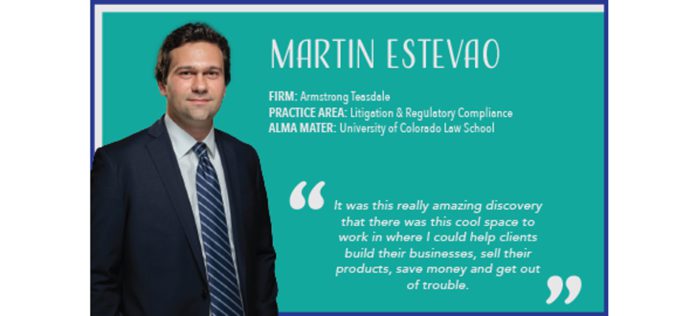
Armstrong Teasdale associate Martin Estevao practices a lot in regulatory compliance, and a significant portion of that work focuses on the food and beverage industry, but it’s not a sector he expected he would end up practicing heavily in. In fact, regulatory compliance wasn’t a practice area he was much aware of until he had the chance to work on compliance efforts for a beverage corporation’s processing and distribution for a milk product the company began selling. Armstrong Teasdale helped the company jump through regulatory hoops, from the routine such as licensing and registration, to the more difficult such as pricing, in order to bring the product to market in every state.
“It really just grew from there into different clients, different companies, different products,” Estevao said. He added the work includes regulatory compliance on issues adjacent to the products themselves, such as packaging, points of sale and exporting. Before he jumped into the regulatory work, he said, he thought the paths to take were transactional practice or litigation. “It was this really amazing discovery that there was this cool space to work in where I could help clients build their businesses, sell their products, save money and get out of trouble.”
He estimates about 15 percent of his practice is devoted to litigation, mostly on the defense side, and the rest to various types of regulatory compliance work. Even when work that lands on his desk contains a new industry, type of issue or regulation he’s not familiar with, Estevao said understanding the client’s business and understanding what makes governments tick are keys to mastering the work.
“Whether it’s the state, county, city, federal [government], the more experience that you get there, the more you can see how government regulators generally act,” he said. “And to be able to get good results in any particular situation, you have to have the right personality.”
Estevao said he enjoys the compliance work because it presents opportunities for creative resolutions that both satisfy regulators and help his clients move their businesses forward. He added that it tends to have a much different tone than litigation, when clients need their attorneys because a lawsuit is already involved.
“If it is a matter of a potential dispute, either with an agency or private customer, there are lots of really creative ways to achieve consensus without going to litigation,” Estevao said.
The work for the beverage corporation was a huge undertaking, but Estevao said he was motivated to join the project because he just enjoys learning new things and solving problems, and the work presented a new product, industry and issues for him.
“It just sounded so unique and interesting, and the person spearheading the work who was the client manager is just an amazing person to work with,” he said. “It was a mixture of people, despite the lack of experience as a first-year, valuing my input and truly giving me the opportunity to run with the ball, and me just really hungry to get after something new.”
The dairy industry is distinctive because of strong competition among local producers who want to protect their business, with strong lobbying presence and political ties. And Estevao’s work for the beverage company took him on some interesting trips, including to North Dakota to make sure the corporation had the green light from the state’s governing dairy agency to sell the product.
The trip was an interesting experience for Estevao because it required him to look outside the bubble of representing the huge beverage corporation and help bridge the gap between the interests of his client and those of small local dairy producers.
“You go in person and see how this industry is affecting them on a day-by-day. They’re dealing with these issues on a basic family sustenance basis,” he said. “How do you have your farmers make enough money so they can survive? Meanwhile, I’m representing a big company who’s bringing in their milk from out of state. … But we got around those differences and ended up coming together with everyone happy at the end of the day.”
Much of the advice Estevao would give himself as a first-year lawyer is client-facing. Stay focused on the client’s business needs, he said, and help them with information and analysis that are immediately useful for the companies to solve their problems. The importance of learning how to communicate well to that end is some of the best advice he’s gotten from mentors, Estevao said.
“At the end of the day, there’s an answer needed, and that’s what we should provide.”
But making sure he doesn’t lose the forest for the trees applies to balancing career goals, too. “Maybe in the first one, two, three years of your career you’re just trying to grind and figure out how to get through the day without getting fired,” he said. “And now it’s really about, how are you going to build your career to make you happy?”
— Julia Cardi

